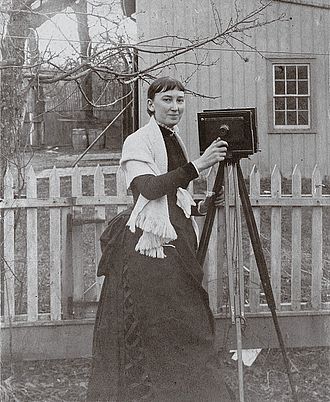Revolutionary changes took place in photography at the end of the nineteenth century that made it more accessible and appealing. Dry plates allowed for later developing, freeing photographers from transporting cumbersome portable dark rooms. After George Eastman’s introduction of the roll-film camera in 1888, followed by new and supposedly better cameras every year, a new market was created. Kodak’s subsequent advertising campaign popularized photography, particularly among women. In addition, the challenges of learning photography were demystified by a profusion of periodicals that flooded the market over the next decades.
Frances and Mary’s brother, Edmund Allen, is thought to have introduced them to the camera. By 1884, Frances and Mary were photographing with a view camera, seen in an albumen print of Mary. Predictably, Frances and Mary’s first photographs document familiar surroundings: their family, neighbors, farms, fields, and old houses in Deerfield. Frances and Mary also seemed to have an innate ability to capture children doing what children like to do. Their earliest, artistically composed, out-of-doors photographs soon attracted attention.
In 1888, the Greenfield Gazette and Courier noted that “The Misses Allen have been photographing twelve ancient doorways for Boston parties.”7 This is the first reference to the collaborative nature of the sisters’ photography business. Their earliest images bear the joint credit line “F. S. & M. E. Allen.”
The direction of the Allen’s work was influenced by the introduction of the halftone, a photomechanical printing process, in 1888. Soon photographic illustrations replaced the prevalent wood engravings in publications.8 Publishers favored Frances and Mary’s photographs of buildings, streetscapes, and scenic landscapes illustrating the built environment. In 1890, Mary photographed the nearby hill town of Conway, Massachusetts, for Horace E. Miller’s Sketches of Conway.9 A year later, Frances and Mary provided photographs of Deerfield for the picture book Picturesque Franklin.10 Mary’s 1892 article “Old Deerfield” in The New England Magazine, in which she recounts the history of the “venerable town, and mother of towns,”11 is illustrated with Allen sisters’ photographs and engravings based on their photographs. Frances and Mary’s carefully-composed and sharply-focused photographs reproduced in these publications established their reputation as skillful photographers.
Photographs courtesy of Memorial Hall Museum, Deerfield, MA.

